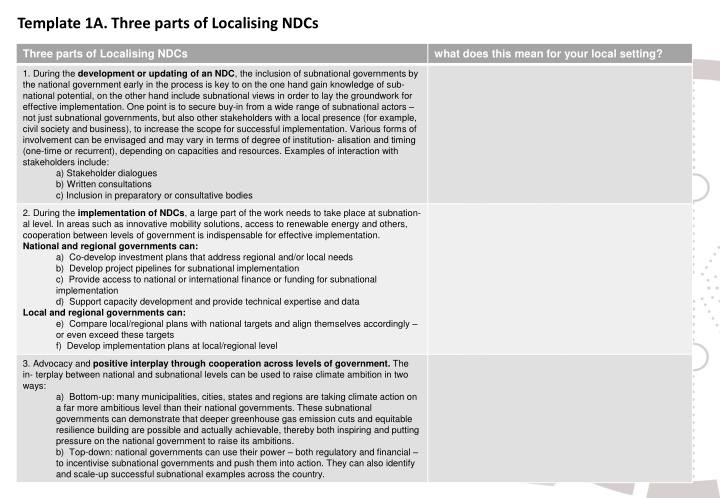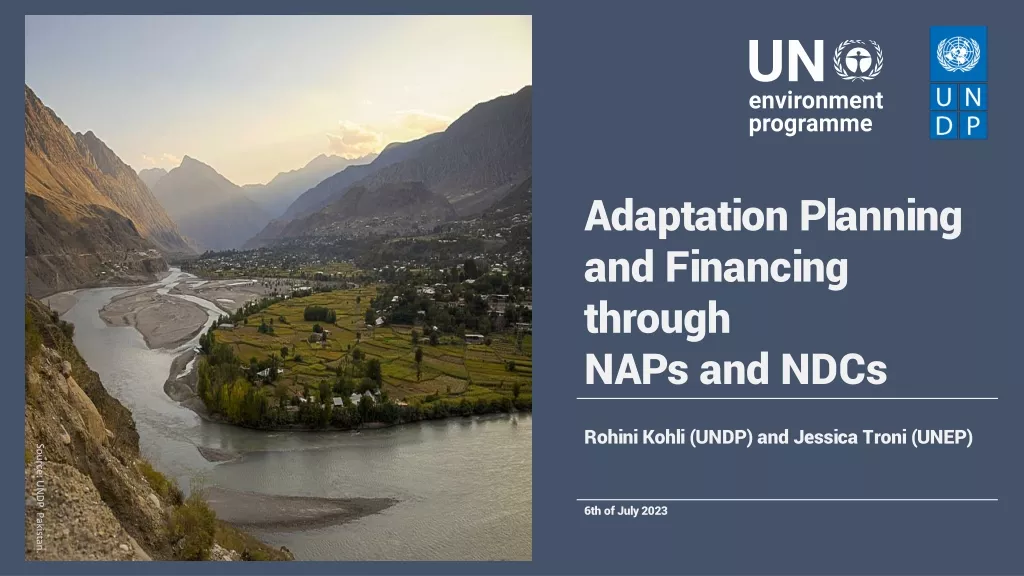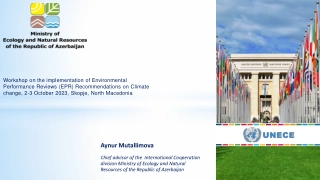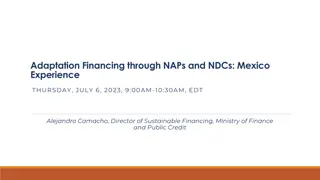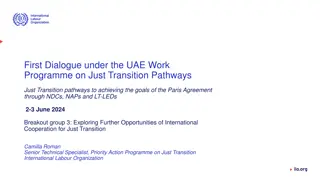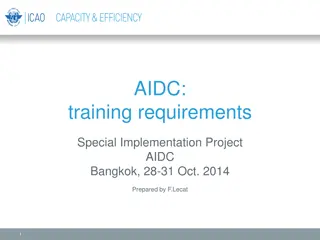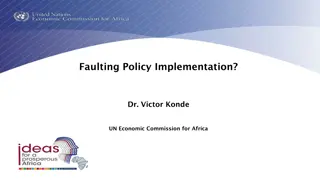Localising NDCs: Key Steps for Effective Implementation
Involving subnational governments early, coordinating with different stakeholders, and advocating for cooperation across government levels are crucial for successful localising of NDCs. This approach enhances implementation effectiveness and fosters climate ambition.
Download Presentation

Please find below an Image/Link to download the presentation.
The content on the website is provided AS IS for your information and personal use only. It may not be sold, licensed, or shared on other websites without obtaining consent from the author.If you encounter any issues during the download, it is possible that the publisher has removed the file from their server.
You are allowed to download the files provided on this website for personal or commercial use, subject to the condition that they are used lawfully. All files are the property of their respective owners.
The content on the website is provided AS IS for your information and personal use only. It may not be sold, licensed, or shared on other websites without obtaining consent from the author.
E N D
Presentation Transcript
Template 1A. Three parts of Localising NDCs Three parts of Localising NDCs what does this mean for your local setting? 1. During the development or updating of an NDC, the inclusion of subnational governments by the national government early in the process is key to on the one hand gain knowledge of sub- national potential, on the other hand include subnational views in order to lay the groundwork for effective implementation. One point is to secure buy-in from a wide range of subnational actors not just subnational governments, but also other stakeholders with a local presence (for example, civil society and business), to increase the scope for successful implementation. Various forms of involvement can be envisaged and may vary in terms of degree of institution- alisation and timing (one-time or recurrent), depending on capacities and resources. Examples of interaction with stakeholders include: a) Stakeholder dialogues b) Written consultations c) Inclusion in preparatory or consultative bodies 2. During the implementation of NDCs, a large part of the work needs to take place at subnation- al level. In areas such as innovative mobility solutions, access to renewable energy and others, cooperation between levels of government is indispensable for effective implementation. National and regional governments can: a) Co-develop investment plans that address regional and/or local needs b) Develop project pipelines for subnational implementation c) Provide access to national or international finance or funding for subnational implementation d) Support capacity development and provide technical expertise and data Local and regional governments can: e) Compare local/regional plans with national targets and align themselves accordingly or even exceed these targets f) Develop implementation plans at local/regional level 3. Advocacy and positive interplay through cooperation across levels of government. The in- terplay between national and subnational levels can be used to raise climate ambition in two ways: a) Bottom-up: many municipalities, cities, states and regions are taking climate action on a far more ambitious level than their national governments. These subnational governments can demonstrate that deeper greenhouse gas emission cuts and equitable resilience building are possible and actually achievable, thereby both inspiring and putting pressure on the national government to raise its ambitions. b) Top-down: national governments can use their power both regulatory and financial to incentivise subnational governments and push them into action. They can also identify and scale-up successful subnational examples across the country.
Template 1B. Recommendations and short/long term ideas Recommendations Short-term ideas Long-term ideas At local level: 1. Address interlinkages between the 2030 Agenda and the Paris Agreement and capitalise on synergies for effective and efficient use of resources. Also expect to deal with incoherencies and clashing demands. SDGs can be a reference framework in terms of integrated, horizon- tal and vertical sustainable development policies and planning and of stakeholder engage- ment. 2. Use existing or create new coordination mechanisms with regional and national levels of government and with other local actors. 3. Learn from and be inspired by other subnational actors. Horizontal cooperation can also positively influence international processes. 4. Require contractors (for example, energy services) to perform their services in a way that is compatible with the goals of the Paris Agreement. 5. Assess the likely impact of policy change in localised NDCs on both women and men, given gender roles and gender relations, their constraints and decision-making power. This could also be done for LGBTQ communities, ethnic and religious minorities, and different age groups. 6. A shared regional localisation strategy can be a good way of ensuring that smaller cities (with more limited capacity) are also part of the process. At national level: 1. Incorporate the efforts of subnational governments, many of whom are already showcasing that deeper greenhouse gas cuts are, in fact, achievable, in both developing or updating NDCs and in implementing them. However, subnational governments are not only imple- menting bodies but also cooperation partners in both phases. 2. Co-design localisation strategies that create the necessary framework conditions and reduce existing incoherencies between national regulations and between sectoral policies. National climate plans need to be aligned with SDG strategies and enhance the role and responsibili- ties of subnational governments. 3. Improve the multi-level governance architecture or create new coordination mechanisms both for climate action and for implementation of the 2030 Agenda, strengthening the participation of subnational governments in all phases. Discussing targets, strategies, instru- ments and indicators together creates ownership and buy-in amongst those involved. 4. Expand (access to) financial support for subnational governments, which often have limited resources and limited scope for finding funding. 5. Support joint efforts for monitoring and data disaggregation to strengthen national and local capacities to assess potential and progress. 6. Facilitate and support peer to peer exchange and mutual learning among local governments and their networks, to disseminate good practices and create emulation.
Recommendation 2. Governance capacities / instruments for multi- level climate governance Refer to recommendation chapter pg. 82 ff 3 Source: https://collaborative-climate-action.org/wp-content/uploads/2019/11/Multi-Level-Climate-Governance.pdf
Template 2. Governance capacities Instrument Recommendations / Rationale How can your city take this forward? Initial ideas Monitoring and reporting Recommendation: Government and international partners/cooperation should support the development of national pro- grammes for city-scale GHG emissions inventories as well as local vulnerability assessments to ensure that the data collected is comparable and can be aggregated. This may also include (financial) support for adequately trained local personnel that are able to collect and analyse relevant data. National governments should also ensure that relevant available data e.g. national statistics is spatially disaggregated to allow for comparisons of progress at the sub- national level. International partners should support the identification of monitoring and reporting methodologies that lead to useful comparable data for mitigation and adaptation efforts at the local level. All levels: Information and knowledge are key strategic requirements to enable action at different levels. Local: Based on data from GHG sources and on climate change impacts, local governments are able to identify the key entry points and priorities for action. National: National governments are able to conduct progress-tracking and monitoring of implementation through data generated at the local level. This information in turn can be used as evidence for future policy decisions. International: Urban data can contribute to the implementation of the Paris Agreement through better understanding of local emissions levels. Information and knowledge Certification and award schemes Recommendations: National governments looking to establish long-term institutionalised processes supporting local climate action that contributes to the achievement of national targets should consider the introduction of certification schemes. Depending on the design of such certification schemes, they can also encourage the establishment of municipal climate management teams to guide local climate action in the long term. In addition, national and local governments can consider introducing certification and award schemes in certain sectors to encourage investment and innovation. Local: On-the-ground climate solutions are recognised (and ideally supported financially). Depend- ing on the sector addressed, local governments can communicate arising co-benefits to other local governments. National: National governments obtain insights on solutions on the ground that can inform further national policies. National governments can more- over incentivise, recognise and identify standards, processes and benchmarks. Private sector: Based on the nature of the schemes, private sector players may have significant incentives to contribute to and benefit from innovative solutions.
Governance capacities Instrument Recommendations / Rationale How can your city take this forward? Municipal own-source revenues Recommendations: The overall principle of adequate fiscal decentralisation (not only strictly linked with tasks related to climate change mitigation and adaptation) should be upheld and provisions for its implementation should be established and put into practice by the national government. This clearly also has important repercussion to the climate change policy field, when local government tasks are related to climate change adaptation (for instance water service delivery, spatial planning and storm water management) and/or mitigation (for instance public transport planning and provision, waste management). National governments can help to strengthen the resource base of local governments for targeted functions related to climate policy that are particularly important in the country s NDC. Moreover, national governments and/or relevant partners should carry out assessments examining the extent to which existing domestic policy and regulatory frameworks allow or impede municipal resource-raising power. In addition, processes of climate-sensitive local budgeting may be support- ed, depending on the degree of fiscal, administrative and public sector decentralisation enabled by higher levels of government. Local governments should carry out assessments of financial needs and opportunities to leverage own resources. In addition, local governments should raise awareness and communicate to their constituencies the socio-economic benefits that local climate action has. Local governments gain more independence of intergovernmental transfers (or even international transfers) for policy formulation and improve their resource base for climate action. National: National governments can identify modifications in the domestic framework that can en- able a better local revenue base for climate action. To the extent that local governments use their opportunities to generate own-source revenues for climate action in innovative ways, national governments can also promote successful innovations for adoption by other local governments. Finance Domestic climate and development finance Recommendation: National governments should consider a financial needs assessment for local climate action as a pillar of NDC implementation. Based on this assessment, an investment plan (cross-cutting, sector specific) and/or specific funding arrangements can be established to support local climate activities. Local: Local governments benefit from financing sources that complement the existing locally-owned resource base. National: National governments can capitalise on the potential of local climate action by relying on and complementing existing municipal climate finance structures, or providing alternative sources of funding where the leeway for municipal own source revenues for climate action is too limited. This can complement NDC implementation measures at the national level to achieve intended mitigation and adaptation results.
Governance capacities Instrument Rationale How can your city take this forward? National policy alignment Recommendation: National, regional and local governments should initiate processes of policy coordination to help them define how to move from short-term objective to long-term targets and identify what role the different levels should play. Such processes should also aid in the identification of the concrete measures to be taken at different levels to ensure an enabling environment that is conducive to climate action. All levels: Processes of national policy alignment can help to establish clear mandates and responsibilities for different levels regarding implementation of NDCs. Local: Consultation and coordination processes allow insights from local governments to be included in national policies. National: These processes allow feedback and the evaluation of the effectiveness of national policies on the ground. Coordination and cooperation Inter- municipal and regional cooperation Recommendation: National governments should create rules and regulations in the domestic administrative and policy framework that are conducive to enable effective inter-municipal and regional co-operation. In addition, it can assess, when necessary, whether inter-municipal and regional instruments reshaping competences across jurisdictions are doing so in a manner aligned with democratic legitimacy. Local: Efficiency of local service delivery can be improved through the reduction of costs and economies of scale and scope. Inter-municipal and regional cooperation also allows local governments to bundle their expertise and power and to assure control over relevant assets and functions across boundaries. National and regional: Governance effectiveness can be increased through coherent regional strategies.
Governance capacities Instrument Rationale How can your city take this forward? networks, city twinning and partnerships Recommendation: Local governments looking to establish partnerships and combine their voice with those of other partners should assess whether joining such networks and partnerships is beneficial. Considering the regional biases in the membership of city networks mentioned in section 3.3.3, city networks should endeavour to communicate their tangible benefits such as proven learning and diffusion of good practice to a wider membership. National governments and international partners should recognise the value of city networks as a partner that can aggregate the concerns of local governments and communicate them to higher levels of government, and assist local governments in understanding and localising the Paris Agreement and NDCs. This implies, for example, supporting strong national city networks that have a broad and inclusive membership not just the largest cities in a country. Local: Constructive relations with domestic and transnational peers facilitate exchanges of experiences and peer learning amongst local governments. Participation in networks may also be of value to local governments to the extent that it increases recognition and prestige. National: Domestic partnerships and networks can be a valuable partner to involve the voice of local government in consultations. Coordination and cooperation Human resources and capacities Recommendation: National and local governments should ensure that adequate personnel working on climate change is attracted to the public sector and included in their budgets. Through its university system and national public administration academies, national governments should ensure high-quality education of skilled engineers, architects and public sector staff to prepare them to deal with climate change uncertainty, cross- cutting planning and specific technical issues related to climate change mitigation and adaptation. Inter- national partners should continue supporting on-the- job capacity development for government officials in all departments of the local, regional and national level on climate issues. All levels: Skilled personnel and sufficient staff in the public sector are a necessary condition for local climate action. Local: Adequate personnel enables local governments, inter alia, to make use of available funding instruments, to develop and implement locally- owned local climate action plans on the ground, to connect climate change priorities meaningfully with their service delivery and socio-economic mandates and to respond to the needs of their local constituencies. National: Supporting training of municipal employees at the local level makes local governments effective partners in implementing NDCs. At the national level, e.g. ministerial employees need to have sufficient capacities and knowledge to be able to effectively coordinate climate policy across different ministries. Institutional
Recommendation 3. Collaborative Climate Action requires a political will and good processes Successful cooperation across levels of government is not contingent on money, external support or internationally set rules. A political will to engage in cooperation is crucial . Source: https://collaborative-climate-action.org/wp-content/uploads/2021/02/CCA-a-prerequisite-for-more-ambitious-climate-action.pdf
